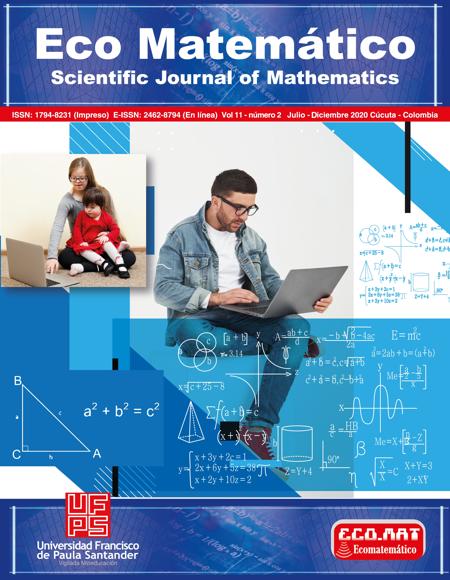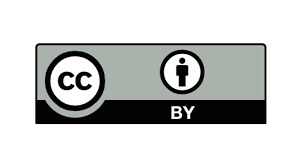Dificultades alrededor de tareas algebraicas, ¿Existen diferencias de genero?
Dificultades alrededor de tareas algebraicas, ¿Existen diferencias de genero?
Main Article Content
This article is a preview of the results derived from an investigation that seeks to determine the weaknesses and strengths that tenth grade students at a private educational institution exhibit when solving algebraic problems. A quantitative approach is adopted at the cross-sectional descriptive level. A non-probabilistic sample of size 40 students, with an average age of 15 years old is selected. A questionnaire composed by 15 items is applied to them, where daily or general interest situations are proposed, in which diverse semiotic registers of representation are articulated. Overall, a 54% error rate was found. As for the strengths, it is highlighted that at least three out of four students can correctly articulate between statements of daily situations with their respective two-dimensional graphical record where the variables Time vs. other variable such as Speed, Temperature or Length are related. Finally, difficulties were evidenced in situations associated with the application of factorial decomposition in the solution of equations and in the establishment of order relations between quantities expressed in different units of measure.
Downloads
Article Details
Arboledas, L. E., Hernández-Suárez, C. A., & Paz-Montes, L. S. (2020). Evolution of the algebraic error in the evaluation processes mathematics and physics in engineering students. Journal of Physics: Conference Series, 1645(1), 012016. https://doi.org/10.1088/1742-6596/1645/1/012016
Arias, F. G. (2012). El proyecto de investigación. Introducción a la metodología científica. Caracas: Episteme
Diaz, A., Hernández, C. A., & Paz, L. S. (2019). Errors and difficulties in solving algebraic procedures in secondary school students. Journal of Physics: Conference Series, 1408(1), 012010. https://doi.org/10.1088/1742-6596/1408/1/012010
Engler, A., Gregorini, M. I., Müller, D., Vrancken, S., & Hecklein, M. (2004). Los errores en el aprendizaje de matemática. Revista Premisa, 6(23), 23-32. http://www.soarem.com.ar/Documentos/23%20Engler.pdf
Espíndola, A., Gutiérrez, M., Castellanos, X., Yordi, I., & Miranda, M. (2012). Estrategia didáctica para la dinámica del proceso docente educativo de la Matemática en la especialidad Bioestadística. Humanidades Médicas, 12(2), 347- 359. http://www.humanidadesmedicas.sld.cu/index.php/hm/article/view/168
Espinosa-Guia, C. (2010). Diferencias entre hombres y mujeres en educación matemática: ¿Qué pasa en México? Investigación y Ciencia, 18(46), 28-35. https://biblat.unam.mx/hevila/InvestigacionycienciaUniversidadautonomadeaguascalientes/2010/vol18/no46/4.pdf
Fuentes de Frutos, S., y Renobell-Santaren, V. (2020). La influencia del género en el aprendizaje matemático en España. Evidencias desde PISA. Cultura educación y sociedad, 11(1), 71-86. https://doi.org/10.17981/cultedusoc.11.1.2020.05
Gamboa Araya, R. (2012). Gender Equality in Mathematics Education? Revista Electrónica Educare, 16(1), 63-78. https://doi.org/10.15359/ree.16-1.6
Gómez, P. (2010). Diseño curricular en Colombia: el caso de las matemáticas (Documento de Trabajo). Granada: Universidad de Granada. http://funes.uniandes.edu.co/11741/1/Gomez2018Curriculo.pdf
Guacaneme, E. A., Obando, G., Garzón, D., & Villa-Ochoa, J. A. (2013). Informe sobre la Formación inicial y continua de Profesores de Matemáticas: El caso de Colombia. Cuadernos de Investigación y Formación en Educación Matemática, 8, 11-49. http://funes.uniandes.edu.co/6701/1/document.pdf
Hernández-Suárez, C. A. (2012). Caracterización de la actividad demostrativa en estudiantes de educación superior. Ecomatemático, 3(1), 36-43. https://doi.org/10.22463/17948231.118
Hernández-Suarez, C. A., Ramírez-Leal, P., & Rincón-Álvarez, G. A. (2013). Pensamiento matemático en estudiantes universitarios. Ecomatemático, 4(1), 4-10. https://doi.org/10.22463/17948231.72
Kieran, C, & Filloy Yague, E. (1989). El aprendizaje del álgebra escolar desde una perspectiva psicológica. Enseñanza de las ciencias, 7 (3), 229-240. https://www.raco.cat/index.php/Ensenanza/article/view/51268
Lachapell Maldonado, G. A. (2017). La formación didáctico matemática del docente de la República Dominicana. Transformación, 13(3), 327-337. http://scielo.sld.cu/pdf/trf/v13n3/trf04317.pdf
Orton, A. (2003). Didáctica de las matemáticas. España: ediciones Morata.
Rus Arboledas, A. (2010). Los problemas de la educación. Profesorado. Revista de Currículum y Formación de Profesorado, 14 (1), 415-427. https://recyt.fecyt.es/index.php/profesorado/article/view/42255
Socas, M. (2007). Dificultades y errores en el aprendizaje de las matemáticas. Análisis desde el enfoque lógico semiótico. En Camacho, M.; Flores, P.; Bolea, M. P. (Eds.), Investigación en educación matemática (pp. 19-52). San Cristóbal de la Laguna, Tenerife: Sociedad Española de Investigación en Educación Matemática, SEIEM. http://funes.uniandes.edu.co/1247/1/Socas2008Dificultades_SEIEM_19.pdf
Stenhouse, L. (1988). Investigación y desarrollo del currículo. Madrid: Morata
Torres, M., Salazar, F. G., & Paz, K. (2019). Métodos de recolección de datos para una investigación. Boletín Electrónico, 3. http://fgsalazar.net/LANDIVAR/ING-PRIMERO/boletin03/URL_03_BAS01.pdf







